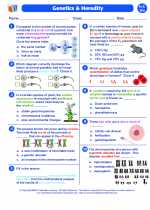Genetics and heredity I -> allele
Allele Explanation and Study Guide
Explanation
An allele is a variant form of a gene. Genes are the basic units of heredity, and they are made up of DNA. Each gene can have different versions, or alleles, which can result in different traits or characteristics. For example, the gene for hair color may have alleles for blonde, brown, or black hair.
Alleles are found on corresponding positions, or loci, on homologous chromosomes. Individuals inherit one allele for each gene from each parent. These alleles may be the same (homozygous) or different (heterozygous).
Study Guide
1. Definition
Define allele and explain its relationship to genes and traits.
2. Types of Alleles
Discuss the different types of alleles, including dominant, recessive, and co-dominant alleles. Provide examples of each type.
3. Allele Frequencies
Explain the concept of allele frequencies in a population and how they can change over time through processes such as natural selection, genetic drift, and gene flow.
4. Genetic Crosses
Practice solving genetic crosses using Punnett squares to predict the outcomes of offspring based on allele combinations.
5. Genetic Disorders
Explore how alleles can contribute to genetic disorders and diseases. Discuss examples such as sickle cell anemia, cystic fibrosis, and Huntington's disease.
[Allele] Related Worksheets and Study Guides:
.◂Biology Worksheets and Study Guides High School. Genetics and heredity I

 Worksheet/Answer key
Worksheet/Answer key
 Worksheet/Answer key
Worksheet/Answer key
 Worksheet/Answer key
Worksheet/Answer key
 Vocabulary/Answer key
Vocabulary/Answer key
 Vocabulary/Answer key
Vocabulary/Answer key
 Vocabulary/Answer key
Vocabulary/Answer key
 Vocabulary/Answer key
Vocabulary/Answer key
 Vocabulary/Answer key
Vocabulary/Answer key
 Vocabulary/Answer key
Vocabulary/Answer key
 Vocabulary/Answer key
Vocabulary/Answer key
